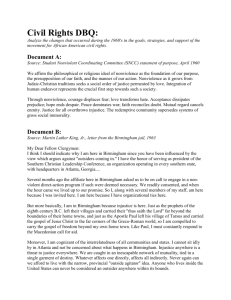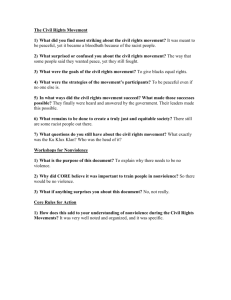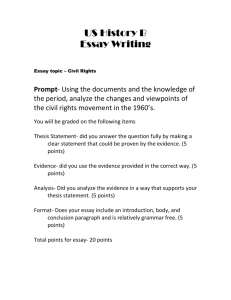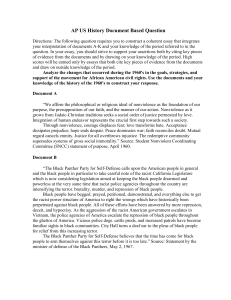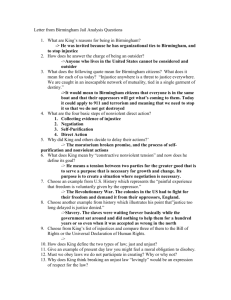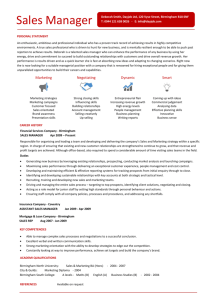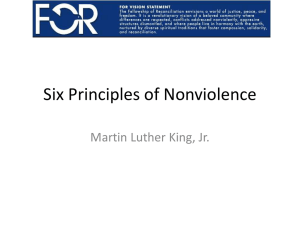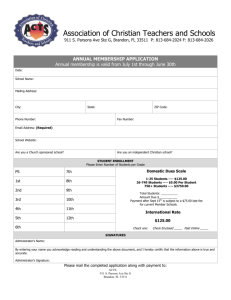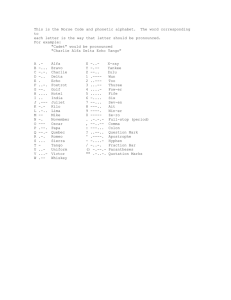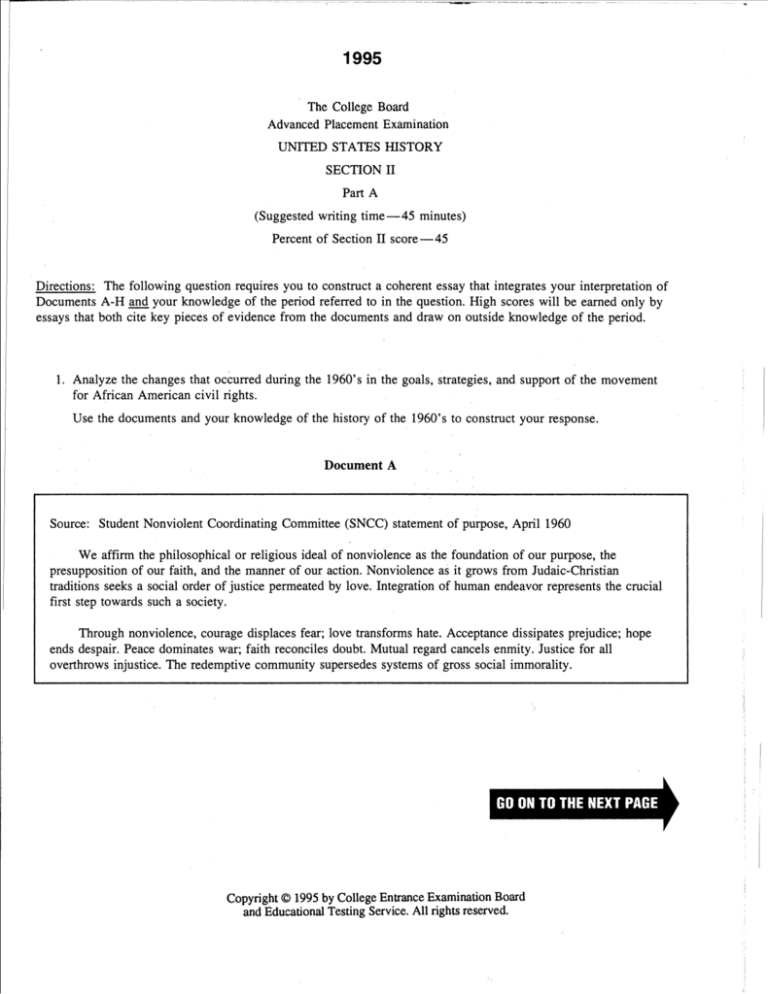
The College Board
Advanced Placement Examination
UNITED STATES HISTORY
SECTION I1
Part A
(Suggested writing time-45
minutes)
Percent of Section I1 score-45
Directions: The following question requires you to construct a coherent essay that integrates your interpretation of
Documents A-H g& your knowledge of the period referred to in the question. High scores will be earned only by
essays that both cite key pieces of evidence from the documents and draw on outside knowledge of the period.
1. Analyze the changes that occurred during the 1960's in the goals, strategies, and support of the movement
for African American civil rights.
Use the documents and your knowledge of the history of the 1960's to construct your response
I
Document A
Source: Student Nonviolent Coordinating Committee (SNCC) statement of purpose, April 1960
We affirm the philosophical or religious ideal of nonviolence as the foundation of our purpose, the
presupposition of our faith, and the manner of our action. Nonviolence as it grows from Judaic-Christian
traditions seeks a social order of justice permeated by love. Integration of human endeavor represents the crucial
first step towards such a society.
Through nonviolence, courage displaces fear; love transforms hate. Acceptance dissipates prejudice; hope
ends despair. Peace dominates war; faith reconciles doubt. Mutual regard cancels enmity. Justice for all
overthrows injustice. The redemptive community supersedes systems of gross social immorality.
Copyright O 1995 by College Entrance Examination Board
and Educational Testing Service. All rights reserved.
Document B
I
Source: Martin Luther King, Jr., letter from the Birmingham jail, 1963
I
My Dear Fellow Clergymen:
I think I should indicate why I am here in Birmingham since you have been influenced by the view which
argues against "outsiders coming in." I have the honor of serving as president of the Southern Christian
Leadership Conference, an organization operating in every southern state, with headquarters in Atlanta, Georgia.
* * *
Several months ago the affiliate here in Birmingham asked us to be on call to engage in a non-violent directaction program if such were deemed necessary. We readily consented, and when the hour came we lived up to
our promise. So I, along with several members of my staff, am here because I was invited here. I am here
because I have organizational ties here.
But more basically, I am in Birnlingham because injustice is here. Just as the prophets of the eighth century
B.C. left their villages and canied their "thus saith the Lord" far beyond the boundaries of their home towns, and
just as the Apostle Paul left his village of Tarsus and carried the gospel of Jesus Christ to the far corners of the
Greco-Roman world, so I am compelled to cany the gospel of freedom beyond my own home town. Like Paul, I
must constantly respond to the Macedonian call for aid.
Moreover, I am cognizant of the interrelatedness of all communities and states. I cannot sit idly by in
Atlanta and not be concerned about what happens in Birmingham. Injustice anywhere is a threat to justice
everywhere. We are caught in an inescapable network of mutuality, tied in a single garment of destiny. Whatever
affects one directly, affects all indirectly. Never again can we afford to live with the narrow, provincial "outside
agitator" idea. Anyone who lives inside the United States can never be considered an outsider anywhere within
its bounds.
Reprinted by arrangement with The Heirs to the Estate of Martin Luther King, Jr.,
c/o Joan Daves Agency as agent for the proprietor.
I1
1995
Document D
Source: President John F. Kennedy in a radio and television report to the American people June 11, 1963
We are confronted primarily with a moral issue. It is as old as the scriptures and is as clear as the American
Constitution.
The heart of the question is whether all Americans are to be afforded equal rights and equal opportunities,
whether we are going to treat our fellow Americans as we want to be treated. . . ,
The fires of frustration and discord are burning in every city, North and South, where legal remedies are not
at hand. Redress is sought in the streets, in demonstrations, parades, and protests which create tensions and
threaten violence and threaten lives.
We face, therefore, a moral crisis as a country and a people. It cannot be met by repressive police action. It
cannot be left to increased demonstrations in the streets. It cannot be quieted by token moves or talk. It is a time
to act in the Congress, in your state and local legislative body and, above all, in all of our daily lives. . , .
Next week I shall ask the Congress of the United States to act, to make a commitment it has not fully made
in this century to the proposition that race has no place in American life or law.
Document E
Source: Stokely Carmichael in "What We Want," 1966
But our vision is not merely of a society in which all black men have enough to buy the good things of life.
When we urge that black money go into black pockets, we mean the communal pocket. We want to see money
go back into the community and used to benefit it. We want to see the cooperative concept applied in business
and banking. We want to see black ghetto residents demand that an exploiting store keeper sell them, at minimal
cost, a building or a shop that they will own and improve cooperatively; they can back their demand with a rent
strike, or a boycott, and a community so unified behind them that no one else will move into the building or buy
at the store. The society we seek to build among black people, then, is not a capitalist one. It is a society in
which the spirit of community and humanistic love prevail.
1995
Document F
Source: Statement by the minister of defense of the Black Panthers, May 2, 1967
The Black Panther Party for Self-Defense calls upon the American people in general and the black people
in particular to take careful note of the racist California Legislature which is now considering legislation aimed at
keeping the black people disarmed and powerless at the very same time that racist police agencies throughout the
country are intensifying the terror, brutality, murder, and repression of black people.
Black people have begged, prayed, petitioned, demonstrated, and everything else to get the racist power
structure of America to right the wrongs which have historically been perpetrated against black people. All of
these efforts have been answered by more repression, deceit, and hypocrisy. As the aggression of the racist
American government escalates in Vietnam, the police agencies of America escalate the repression of black
people throughout the ghettoes of America. Vicious police dogs, cattle prods, and increased patrols have become
familiar sights in black communities. City Hall turns a deaf ear to the pleas of black people for relief from this
increasing terror.
The Black Panther Party for Self-Defense believes that the time has come for black people to arm
themselves against this terror before it is too late.
Document G
ESTIMATED PERCENTAGE OF VOTING-AGE AFRICAN AMERICANS
REGISTERED IN 1960 AND 1968
State
1960
1968
Alabama
Arkansas
Florida
13.7
37.3
38.9
56.7
67.5
62.1
Georgia
Louisiana
Mississippi
29.3
30.9
5.2
56.1
59.3
59.4
N. Carolina
S. Carolina
Tennessee
38.1
15.6
58.9
55.3
50.8
72.8
Texas
Virginia
34.9
22.8
83.1
58.4
Total South
29.1
62.0
1995
Document H
VOTING IN SELECTED STATES IN THE 1968 ELECTION
(with voting totals for all states)
CANDIDATES FOR PRESIDENT AND VICE PRESIDENT
Democratic -Hubert H. Humphrey; Edmund Muskie
Republican -Richard M. Nixon; Spiro T. Agnew
American Independent Party -George C. Wallace; Curtis LeMay
(in thousands)
Electoral Vote
State
-
Dem.
-
Alabama . . . . . . . . . . 197
Arkansas . . . . . . . . . . 188
California . . . . . . . . 3,244
Rep.
147
1'91
3,468
AIP
Florida . . . . . . . . . . . 677
Georgia . . . . . . . . . . 344
Illinois . . . . . . . . . . 2,040
887
380
2,175
624
536
391
Indiana . . . . . . . . . . . 807
Kentucky . . . . . . . . . 398
Louisiana . . . . . . . . . 3 10
1,068
462
258
243
193
530
---------
Maryland . . . . . . . . . 538
Massachusetts . . . . . 1,469
Michigan . . . . . . . . 1,593
518
767
1,371
179
87
332
10
14
21
Mississippi . . . . . . . . 151
Missouri . . . . . . . . . . 791
New Jersey . . . . . . . 1,264
89
812
1,325
415
206
262
----
New York . . . . . . . . 3,378
North Carolina . . . . . 464
Ohio . . . . . . . . . . . 1,701
3,008
627
1,791
359
496
467
43
Oklahoma . . . . . . . . . 302
Pennsylvania . . . . . . 2,259
South Carolina . . . . . 197
450
2,090
254
192
379
215
Tennessee . . . . . . . . . 35 1
Texas . . . . . . . . . . . 1,267
Virginia . . . . . . . . . . 442
Wisconsin . . . . . . . . . 749
473
1,228
590
810
425
584
322
128
Totals of all
50 states . . . . . . . . 31,275
31,785
9,906
D
--
69 1
24 1
487
----
END OF DOCUMENTS FOR QUESTION 1
-
-
-
R
--
--
40
14
--
26
13
9
------
12
17
AIP
10
6
---
12
----
10
---
-7
---
-12
26
-1
--
8
29
--
---
---
8
25
---
--
----
191
301
46
11
12
12
---

